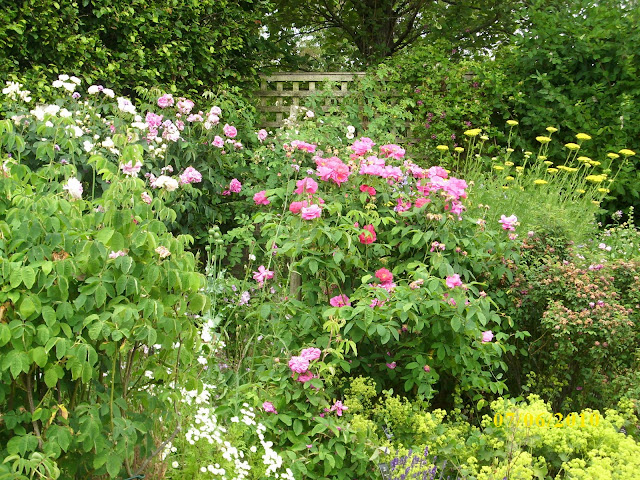 |
One of the many planting groups in St. James Park. Notice the contrast of the hot and cool colors.
Very striking! |
I thought I would show you some of the pictures I took of the gardens in England. I didn't go on a gardening tour and I didn't set out to take snap shots of plants, but England is so lush and verdant that I couldn't help but notice all the natural beauty. Just imagine what it would be like to go on a gardening tour of Great Britain or to plan to go to the best gardens in the country. Hum...now there's an idea for a vacation. I hope you enjoy these!
St. James Park in London.
St. James is one of the parks that connects to Buckingham Palace. It use to be a royal hunting ground, but over the centuries became more of a pleasure ground with a scenic lake and beautiful flower beds.
 |
The Bird Master's cottage from across the small lake.
Plane trees like this one cover London. They are like sycamore trees on steroids, sort of the Arnold Schwarzenegger of the sycamore family. They develop a lot of personality as they mature. This one in St. James seemed to have a face.
Parts of St. James Park are left natural. Actually they are probably carefully crafted to look natural. Either way, they give us an idea of how London might have looked hundreds of years ago. And yes, daisies do grow wild in the countryside!
One of the more formal flower beds. They really like the contrast of colors. I like those incredible dahlias.
I never did find out what this purple tree was. They were too big to be any of the plum trees we
grow in our neck of the woods. Also, did you notice the blue sling back chairs under the trees.
You can rent those sling back chairs by the hour.
Hampton Court
Hampton Court is about an hour by train southwest of London. It has been a royal residence since Henry the VIII acquired the house from Cardinal Wolsey. Most of the kings and queens added something to the house or the gardens, so there is a sort of architectural and gardening record on the grounds. The gardens are fabulous and enormous and exhausting. I have been there twice and I still haven't seen all of the gardens!
The Tudor knot gardens are my favorites! This garden is surrounded by hedges. Every fifteen feet or so, a small peep hole, just big enough for one person, has been cut into the hedges. It's fun to walk a few feet and look into the next peek-a-boo window to see the garden from a new perspective.
Also, if you click on the picture to enlarge it, you can see the two gardeners close to the entrance of the garden. I didn't notice them at first, but as I continued around the peep holes, I started to realize that there was some drama going on! |
 |
| I took my time strolling around this luscious garden, not really focusing on these two men But slowly it began to register with me that the entire fifteen minutes or so that I was admiring the garden, these two were busy, intently discussing something. Get a load of the body language! |
By this time, I was curious! What were they talking about? They didn't seem to angry at each other. It was more like they were chewing apart their boss or complaining about some new, stupid gardening directive that had come down from the know-nothing top brass. I know it's wrong to eavesdrop, but I was intrigued! Try as I might, and I did try, I could not overhear what they were talking about. To my extreme disappointment, their country accents were so strong that I just couldn't make heads or tails of it. I'll admit it; I'm still curious!
 |
This is a great example of the famous English herbaceous border! The planting bed lined the walkway from the William and Mary Gardens all the way to the Rose Gardens. It had to be at least a football field long. And, the bed was at least seven to eight feet deep. Just imagine all the weeding!
|
 |
| This ancient wisteria vine is about four hundred years old! It smelled divine! |
Modern English gardening seems to be all about contrast, contrast of color and texture. This bed was labeled an exotic bed. Exotic! These are mostly old faithfuls at home. Dusty Miller. Variegated monkey grass. Begonias. Serpent Tongue. Palms. Iron plants. Hen and chickens.
It's funny how exotic means different things to different people!
 |
These are the much more formal William and Mary gardens which were modeled on the French style.
They are beautiful and enormous but a little repetitive, not quite as interesting as the Tudor gardens. |













































